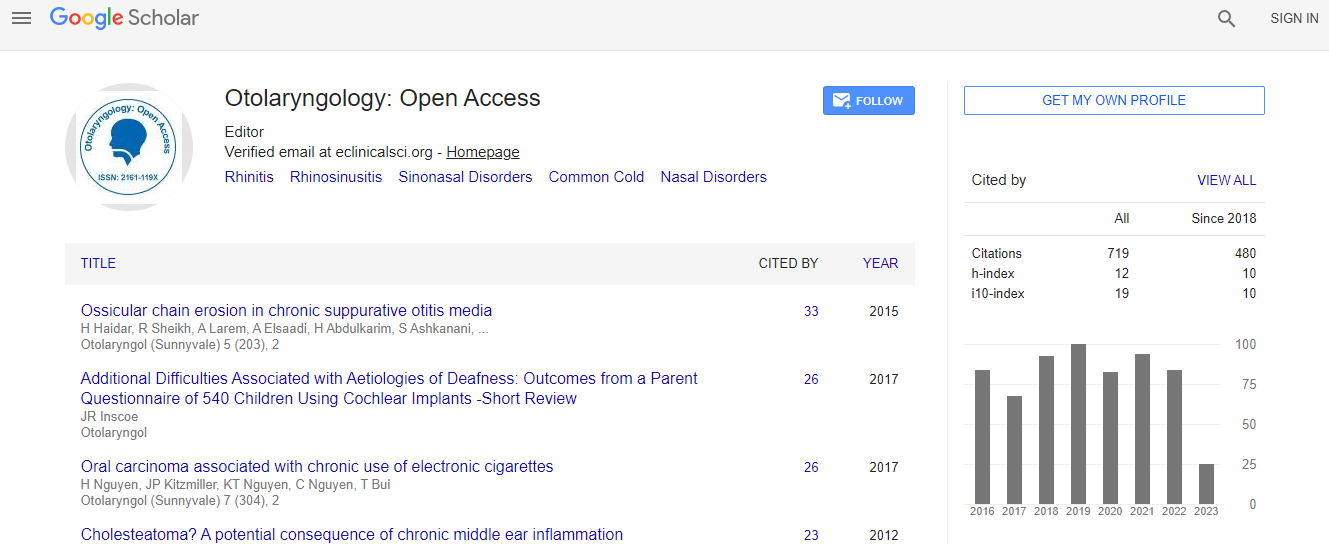Our Group organises 3000+ Global Conferenceseries Events every year across USA, Europe & Asia with support from 1000 more scientific Societies and Publishes 700+ Open Access Journals which contains over 50000 eminent personalities, reputed scientists as editorial board members.
Open Access Journals gaining more Readers and Citations
700 Journals and 15,000,000 Readers Each Journal is getting 25,000+ Readers
Google Scholar citation report
Citations : 925
Otolaryngology: Open Access received 925 citations as per Google Scholar report
Otolaryngology: Open Access peer review process verified at publons
Indexed In
- Index Copernicus
- Google Scholar
- Sherpa Romeo
- Open J Gate
- Genamics JournalSeek
- RefSeek
- Hamdard University
- EBSCO A-Z
- OCLC- WorldCat
- Publons
- Geneva Foundation for Medical Education and Research
- ICMJE
Useful Links
Recommended Journals
Related Subjects
Share This Page
Pathogenesis of the upper airway cough syndrome
3rd International Conference and Exhibition on Rhinology & Otology
Jana Plevkova
Comenius University, Slovakia
Posters & Accepted Abstracts: Otolaryngology
Abstract
Cough is the most important airway defensive mechanisms and it is also the most frequent reason why people seek medical attention. Acute cough, caused mainly by viral infections is usually self-limited and it disappears naturally. Chronic cough is a part of clinical presentation of chronic respiratory diseases such as COPD, lung fibrosis etc. Moreover, we have a specific group of chronic cough patients with the negative physical examination on the chest and negative chest X-ray. In those chronic coughers the leading causes of cough are bronchial asthma with its clinical phenotypes, gastroesophageal reflux and upper airway disease. Frequent association of chronic cough and rhinitis or rhinosinusitis was a reason for intense studies of this phenomenon leading to a change of the terminology; it was renamed from ├ó┬?┬?post nasal drip├ó┬?┬Ł to ├ó┬?┬?upper airway cough syndrome├ó┬?┬Ł which reveals more complex pathogenesis. Mechanisms leading to cough in subjects with upper airway diseases are micro aspiration of the inflammatory aerosols into the lower airways, mechanical and chemical irritation of the pharynx by the mucus dripping down from the nasal passages, nasobronchial reflex interactions, reduced warming and moistening of inhaled air due to lack of nasal function with the consequences for the lower airways physiology, spreading of the inflammatory signals via systemic circulation and last but the newest are neural interaction at the level of brainstem which are responsible for sensitisation of the vagal afferent fibres innervating the airways and further sensitisation of the brainstem circuits responsible for neurogenesis of cough and production of cough motor pattern. This mechanism is called cough plasticity. Only identification of the mechanisms responsible for enhanced coughing in rhinitis subjects is the key to the effective treatment.Biography
Email: jplevkova@gmail.com

 Spanish
Spanish  Chinese
Chinese  Russian
Russian  German
German  French
French  Japanese
Japanese  Portuguese
Portuguese  Hindi
Hindi 
